Etiqueta "Estadística"
Se han encontrado 6 Coincidencias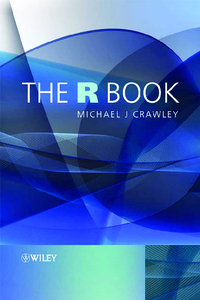
The R Book
Estadística computacional
207 Visitas | 249 Descargas | 2013-10-01 03:27:09 | rmartinez
The high-level language of R is recognized as one of the most powerful and flexible statistical software environments, and is rapidly becoming the standard setting for quantitative analysis, statistics and graphics. R provides free access to unrivalled coverage and cutting-edge applications, enabling the user to apply numerous statistical methods ranging from simple regression to time series or multivariate analysis. Building on the success of the author’s bestselling Statistics: An Introduction using R, The R Book is packed with worked examples, providing an all inclusive guide to R, ideal for novice and more accomplished users alike. The book assumes no background in statistics or computing and introduces the advantages of the R environment, detailing its applications in a wide range of disciplines. Provides the first comprehensive reference manual for the R language, including practical guidance and full coverage of the graphics facilities. Introduces all the statistical models covered by R, beginning with simple classical tests such as chi-square and t-test. Proceeds to examine more advance methods, from regression and analysis of variance, through to generalized linear models, generalized mixed models, time series, spatial statistics, multivariate statistics and much more. The R Book is aimed at undergraduates, postgraduates and professionals in science, engineering and medicine. It is also ideal for students and professionals in statistics, economics, geography and the social sciences.
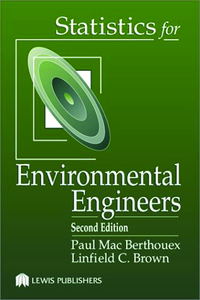
Statistics for Environmental Engineers
132 Visitas | 181 Descargas | 2013-10-03 20:02:30 | efirvida
There are many aspects of environmental problems: economic, political, psychological, medical, scientific, and technological. Understanding and solving such problems often involves certain quantitative aspects, in particular the acquisition and analysis of data. Treating these quantitative problems effectively involves the use of statistics. Statistics can be viewed as the prescription for making the quantitative learning process effective.
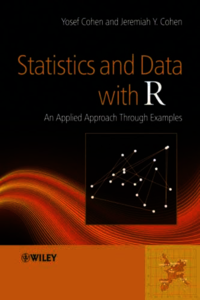
Statistics and Data with R. An applied approach through examples
147 Visitas | 202 Descargas | 2013-10-29 21:40:59 | rmartinez
The book is intended for students, researchers and practitioners both in and out of academia. However, no prior knowledge of statistics is assumed. Consequently, the presentation moves from very basic (but not simple) to sophisticated. Even if you know statistics and R, you may find the many many examples with a variety of real world data, graphics and analyses useful. You may use the book as a reference and, to that end, we include two extensive indices. The book includes (almost) parallel discussions of analyses with the normal density, proportions (binomial), counts (Poisson) and bootstrap methods.
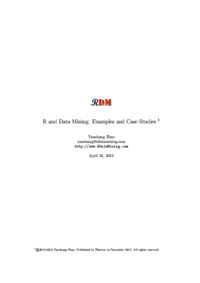
R and Data Mining: Examples and Case Studies
R data mining machine learning analytics
133 Visitas | 171 Descargas | 2014-11-28 16:22:01 | orosado
Chapter 1 Introduction This book introduces into using R for data mining. It presents many examples of various data mining functionalities in R and three case studies of real world applications. The supposed audience of this book are postgraduate students, researchers and data miners who are interested in using R to do their data mining research and projects. We assume that readers already have a basic idea of data mining and also have some basic experience with R. We hope that this book will encourage more and more people to use R to do data mining work in their research and applications. This chapter introduces basic concepts and techniques for data mining, including a data mining process and popular data mining techniques. It also presents R and its packages, functions and task views for data mining. At last, some datasets used in this book are described.
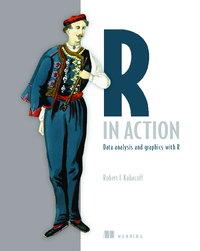
R in Action
Programación en R
100 Visitas | 105 Descargas | 2015-04-30 14:50:46 | josedanielr
R in Action provides you with a guided introduction to R, giving you a 2,000-foot view of the platform and its capabilities. It will introduce you to the most important functions in the base installation and more than 90 of the most useful contributed packages. Throughout the book, the goal is practical application—how you can make sense of your data and communicate that understanding to others. When you finish, you should have a good grasp of how R works and what it can do, and where you can go to learn more. You’ll be able to apply a variety of techniques for visualizing data, and you’ll have the skills to tackle both basic and advanced data analytic problems.
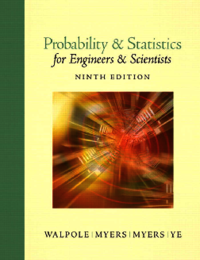
Probability & Statistics for Engineers & Scientists
Matemáticas
137 Visitas | 151 Descargas | 2015-05-07 21:00:51 | josedanielr
In this edition, we continue to emphasize a balance between theory and applications. Calculus and other types of mathematical support (e.g., linear algebra) are used at about the same level as in previous editions. The coverage of analytical tools in statistics is enhanced with the use of calculus when discussion centers on rules and concepts in probability.
Contribuir
Usted puede contribuir con Libros UCLV, es importante para nosotros su aporte..
Contribuir